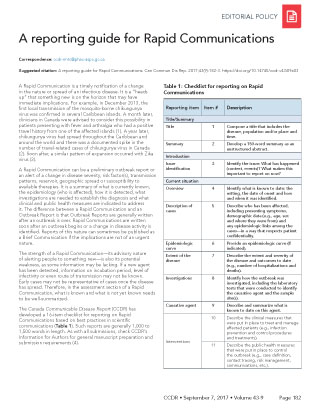Rapid Communication reporting guide

 Download this article as a PDF (127 KB - 2 pages)
Download this article as a PDF (127 KB - 2 pages) Published by: The Public Health Agency of Canada
Issue: Volume 43-9: Scientific writing
Date published: September 7, 2017
ISSN: 1481-8531
Submit a manuscript
About CCDR
Browse
Volume 43-9, September 7, 2017: Scientific writing
Editorial policy
A reporting guide for Rapid Communications
Correspondence
Suggested citation
A reporting guide for Rapid Communications. Can Commun Dis Rep. 2017;43(9):182-3. https://doi.org/10.14745/ccdr.v43i09a03
A Rapid Communication is a timely notification of a change in the nature or spread of an infectious disease. It is a “heads up” that something new is on the horizon that may have immediate implications. For example, in December 2013, the first local transmission of the mosquito-borne chikungunya virus was confirmed in several Caribbean islands. A month later, clinicians in Canada were advised to consider this possibility in patients presenting with fever and arthralgia who had a positive travel history from one of the affected islandsFootnote 1. A year later, chikungunya virus had spread throughout the Caribbean and around the world and there was a documented spike in the number of travel-related cases of chikungunya virus in CanadaFootnote 2. Soon after, a similar pattern of expansion occurred with Zika virusFootnote 3.
A Rapid Communication can be a preliminary outbreak report or an alert of a change in disease severity, risk factor(s), transmission patterns, reservoir, geographic spread or susceptibility to available therapies. It is a summary of what is currently known, the epidemiology (who is affected), how it is detected, what investigations are needed to establish the diagnosis and what clinical and public health measures are indicated to address it. The difference between a Rapid Communication and an Outbreak Report is that Outbreak Reports are generally written after an outbreak is over. Rapid Communications are written soon after an outbreak begins or a change in disease activity is identified. Reports of this nature can sometimes be published as a Brief Communication if the implications are not of an urgent nature.
The strength of a Rapid Communication—its advisory nature of alerting people to something new—is also its potential weakness, as some information may be lacking. If a new agent has been detected, information on incubation period, level of infectivity or even route of transmission may not be known. Early cases may not be representative of cases once the disease has spread. Therefore in the assessment section of a Rapid Communication, what is known and what is not yet known needs to be well-summarized.
The Canada Communicable Disease Report (CCDR) has developed a 16-item checklist for reporting on Rapid Communications based on best practices in scientific communications (Table 1). Such reports are generally 1,000 to 1,500 words in length. As with all submissions, check CCDR's Information for Authors for general manuscript preparation and submission requirementsFootnote 4.
| Reporting item | Item # | Description |
|---|---|---|
| Title/Summary | ||
| Title | 1 | Compose a title that includes the disease, population and/or place and time. |
| Summary | 2 | Develop a 150-word summary as an unstructured abstract. |
| Introduction | ||
| Issue identification | 3 |
Identify the issue: What has happened (context, events)? What makes this important to report on now? |
| Current situation | ||
| Overview | 4 | Identify what is known to date: the setting, the date of onset and how and when it was identified. |
| Description of cases | 5 | Describe who has been affected, including presenting symptoms, demographic data (e.g., age, sex and where they were from) and any epidemiologic links among the cases—in a way that respects patient confidentiality. |
| Epidemiologic curve | 6 | Provide an epidemiologic curve (if indicated). |
| Extent of the disease | 7 | Describe the extent and severity of the disease and outcomes to date (e.g., number of hospitalizations and deaths). |
| Investigations | 8 | Identify how the outbreak was investigated, including the laboratory tests that were conducted to identify the causative agent and the sample site(s). |
| Causative agent | 9 | Describe and summarize what is known to date on this agent. |
| Interventions | 10 | Describe the clinical measures that were put in place to treat and manage affected patients (e.g., infection prevention and control procedures and treatments). |
| 11 | Describe the public health measures that were put in place to control the outbreak (e.g., case definition, contact tracing, risk management, communications, etc.). | |
| Conclusion | ||
| Assessment | 12 | Summarize what is known and identify what is not yet known (e.g., route of transmission, disease reservoir, estimated incubation period, risk factors and effectiveness of treatment). |
| 13 | Consider any relevant reference to previous or similar events. | |
| Implications | 14 | Consider the implications of the outbreak for clinical practice, including any recommendations for case identification and management, infection control and reporting. Identify any sex or gender implications. |
| 15 | Consider the implications for public health practice including any recommendations for surveillance, prevention, risk management and communications. | |
| Conclusion | 16 | Provide a wrap-up summary of what is known to date and the direction of future efforts to understand and control the disease. |